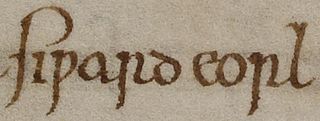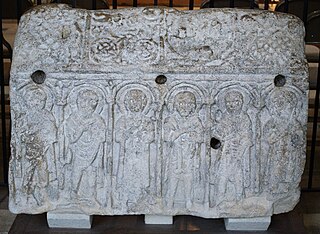Related Research Articles

Crowland or Croyland is a town in the South Holland district of Lincolnshire, England. It is situated between Peterborough and Spalding. Crowland contains two sites of historical interest, Crowland Abbey and Trinity Bridge.

The Croyland Chronicle, also called Crowland Chronicle, is an important primary source for English medieval history, particularly the late 15th century. It is named for its place of origin, the Benedictine Abbey of Croyland or Crowland, in Lincolnshire, England. It was formerly also known as the Chronicle of Ingulf or Ingulphus after its supposed original compiler, the 11th-century abbot Ingulf. As that section of the text is now known to have been a later forgery, its author is instead known as Pseudo-Ingulf. The validity of the source itself has been questioned, partially due to the unknown identity of the original author, and gaps in all continuations of the text. There has also been substantially little effort made to find and translate the original manuscript.

Matthew Paris, also known as Matthew of Paris, was an English Benedictine monk, chronicler, artist in illuminated manuscripts, and cartographer who was based at St Albans Abbey in Hertfordshire. He authored a number of historical works, many of which he scribed and illuminated himself, typically in drawings partly coloured with watercolour washes, sometimes called "tinted drawings". Some were written in Latin, others in Anglo-Norman or French verse. He is sometimes confused with the nonexistent Matthew of Westminster.
Waltheof, Earl of Northumbria was the last of the Anglo-Saxon earls and the only English aristocrat to be executed during the reign of William I.
Anglo-Norman literature is literature composed in the Anglo-Norman language and developed during the period of 1066–1204, as the Duchy of Normandy and the Kingdom of England were united in the Anglo-Norman realm.

Pega is a Christian saint who was an anchoress in the ancient Anglo-Saxon kingdom of Mercia, and the sister of St Guthlac.

Saint Guthlac of Crowland was a Christian hermit and saint from Lincolnshire in England. He is particularly venerated in the Fens of eastern England.

April 10 - Eastern Orthodox liturgical calendar - April 12

Charles Wycliffe Goodwin (1817–1878) was an English Egyptologist, bible scholar, lawyer and judge. His last judicial position was as Acting Chief Judge of the British Supreme Court for China and Japan.

Siward or Sigurd was an important earl of 11th-century northern England. The Old Norse nickname Digri and its Latin translation Grossus are given to him by near-contemporary texts. It is possible Siward may have been of Scandinavian or Anglo-Scandinavian origin, perhaps a relative of Earl Ulf, although this is speculative. He emerged as a regional strongman in England during the reign of Cnut. Cnut was a Scandinavian ruler who conquered most of England in the 1010s, and Siward was one of many Scandinavians who came to England in the aftermath, rising to become sub-ruler of most of northern England. From 1033 at the latest, he was in control of southern Northumbria, present-day Yorkshire, governing as earl on Cnut's behalf.

Ingulf was the Benedictine abbot of Crowland from 1087.

Crowland Abbey is a Church of England parish church, formerly part of a Benedictine abbey church, in Crowland in the English county of Lincolnshire. It is a Grade I listed building.

Medeshamstede was the name of Peterborough in the Anglo-Saxon period. It was the site of a monastery founded around the middle of the 7th century, which was an important feature in the kingdom of Mercia from the outset. Little is known of its founder and first abbot, Sexwulf, though he was himself an important figure, and later became bishop of Mercia. Medeshamstede soon acquired a string of daughter churches, and was a centre for an Anglo-Saxon sculptural style.

Thurcytel was abbot of Crowland and perhaps also of Bedford Abbey.
Saint Fremund, also known as Freomund, was a ninth-century saint, hermit and martyr in Anglo-Saxon England. He is venerated at both the village of Prescote in Oxfordshire, where he is patron saint, and at Dunstable Priory in Bedfordshire.
Guthlac A and Guthlac B are a pair of Old English poems written in celebration of the deeds and death of Saint Guthlac of Croyland, a popular Mercian saint. The two poems are presented consecutively in the important Exeter Book miscellany of Old English poetry, the fourth and fifth items in the manuscript. They are clearly intended to be considered two items, judging from the scribe's use of large initials at the start of each poem. Guthlac A begins on 32v, and Guthlac B begins on 44v.
Jocelyn of Furness was an English Cistercian hagiographer, known for his Lives of Saint Waltheof, Saint Patrick, Saint Kentigern and Saint Helena of Constantinople. He is probably responsible for the popular legendary association of Saint Patrick with snakes, which he purportedly cast out of Ireland.
Osbeorn, also spelled Osbjorn and Osbert, given the nickname Bulax, was the son of Siward, Earl of Northumbria. He is one of two known sons of Siward, believed to be the elder. While it is normally assumed he was the son of Siward's Bamburgh wife Ælfflæd, it has been suggested by William Kapelle that Osbeorn's mother was not Ælfflæd. The nickname "Bulax" probably represents the Old Norse term for "Poleaxe".
Waltheof of Allerdale was an 11th- and 12th-century Anglo-Saxon noble, lord of Allerdale in modern Cumbria. Brother of Dolfin of Carlisle and Gospatric of Dunbar, Waltheof was son of Gospatric, Earl of Northumbria. Both Waltheof and his brother Gospatric witness Earl David's Glasgow Inquest 1113 x 1124, and Waltheof also attests some of David's charters as king of the Scots later. The account of Waltheof and his family in Cumbrian monastic cartularies, says that he gave land in Allerdale to his three sisters, Octreda, Gunhilda and Maud.

Bettelin of Crowland, also known as Beccel, was an 8th century hermit and saint of Crowland, and a follower of Guthlac.
References
- ↑ A Forgotten Saint, Rev. Canon Wood, D.D., The Antiquary (Volume 27), Jan & Jun 1893
- ↑ St John's College Cambridge
- 1 2 The New Advent, Catholic Encyclopedia